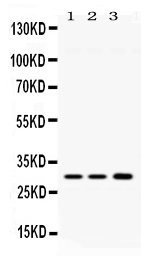Anti-AQP11 Picoband Antibody
- SPECIFICATION
- CITATIONS
- PROTOCOLS
- BACKGROUND

Application
| WB |
|---|---|
| Primary Accession | Q8NBQ7 |
| Host | Rabbit |
| Reactivity | Human, Mouse, Rat |
| Clonality | Polyclonal |
| Format | Lyophilized |
| Description | Rabbit IgG polyclonal antibody for Aquaporin-11(AQP11) detection. Tested with WB in Human;Mouse;Rat. |
| Reconstitution | Add 0.2ml of distilled water will yield a concentration of 500ug/ml. |
| Gene ID | 282679 |
|---|---|
| Other Names | Aquaporin-11, AQP-11, AQP11, AQPX1 |
| Calculated MW | 30203 MW KDa |
| Application Details | Western blot, 0.1-0.5 µg/ml, Human, Mouse, Rat |
| Subcellular Localization | Membrane ; Multi-pass membrane protein . |
| Protein Name | Aquaporin-11 |
| Contents | Each vial contains 5mg BSA, 0.9mg NaCl, 0.2mg Na2HPO4, 0.05mg NaN3. |
| Immunogen | A synthetic peptide corresponding to a sequence at the N-terminus of human AQP11 (35-70aa ARQQLHRPVAHAFVLEFLATFQLCCCTHELQLLSEQ), different from the related mouse sequence by two amino acids, and from the related rat sequence by three amino acids. |
| Purification | Immunogen affinity purified. |
| Cross Reactivity | No cross reactivity with other proteins. |
| Storage | At -20˚C for one year. After r˚Constitution, at 4˚C for one month. It˚Can also be aliquotted and stored frozen at -20˚C for a longer time.Avoid repeated freezing and thawing. |
| Name | AQP11 (HGNC:19940) |
|---|---|
| Synonyms | AQPX1 |
| Function | Channel protein that facilitates the transport of water, glycerol and hydrogen peroxide across membrane of cell or organelles guaranteeing intracellular homeostasis in several organes like liver, kidney and brain (PubMed:24845055, PubMed:24918044, PubMed:31546170). In situation of stress, participates in endoplasmic reticulum (ER) homeostasis by regulating redox homeostasis through the transport of hydrogen peroxide across the endoplasmic reticulum membrane thereby regulating the oxidative stress through the NADPH oxidase 2 pathway (PubMed:31546170). Plays a role by maintaining an environment suitable for translation or protein foldings in the ER lumen namely by participating in the PKD1 glycosylation processing resulting in regulation of PKD1 membrane trafficking thereby preventing the accumulation of unfolding protein in ER (By similarity). Plays a role in the proximal tubule function by regulating its endosomal acidification (By similarity). May play a role in postnatal kidney development (By similarity). |
| Cellular Location | Endoplasmic reticulum membrane; Multi-pass membrane protein. Cytoplasmic vesicle membrane; Multi-pass membrane protein. Cell membrane {ECO:0000250|UniProtKB:F6S3G9}; Multi-pass membrane protein. Note=Localizes mainly to the periphery of lipid droplets (PubMed:24845055). Localizes to cytoplasmic vesicles in maturing spermatozoa (PubMed:28042826). It accumulates partly in mitochondrial-associated endoplasmic reticulum membranes (PubMed:31546170). |
| Tissue Location | Detected in the sperm head and tail (at protein level) (PubMed:28042826). Expressed in subcutaneous adipocytes (PubMed:24845055). Expressed in testis, kidney and ejaculated spermatozoa (PubMed:19812234). |

Thousands of laboratories across the world have published research that depended on the performance of antibodies from Abcepta to advance their research. Check out links to articles that cite our products in major peer-reviewed journals, organized by research category.
info@abcepta.com, and receive a free "I Love Antibodies" mug.
Provided below are standard protocols that you may find useful for product applications.
Background
AQP11 has a unique asparagine-proline-alanine (NPA) box distinct from those of other AQPs, suggesting a different pore structure and function. Using Northern blot analysis, they detected highest expression of mouse Aqp11 in testis, followed by liver and kidney. Expression was much weaker in heart, brain, and muscle. Western blot analysis of mouse kidney membrane fractions detected Aqp11 at an apparent molecular mass of 26 kD, lower than the calculated molecular mass of 30 kD. Immunohistochemical analysis localized Aqp11 to mouse renal proximal tubule cells, where it showed a perinuclear distribution. Fluorescence-tagged Aqp11 localized with an endoplasmic reticulum marker.
If you have used an Abcepta product and would like to share how it has performed, please click on the "Submit Review" button and provide the requested information. Our staff will examine and post your review and contact you if needed.
If you have any additional inquiries please email technical services at tech@abcepta.com.













 Foundational characteristics of cancer include proliferation, angiogenesis, migration, evasion of apoptosis, and cellular immortality. Find key markers for these cellular processes and antibodies to detect them.
Foundational characteristics of cancer include proliferation, angiogenesis, migration, evasion of apoptosis, and cellular immortality. Find key markers for these cellular processes and antibodies to detect them. The SUMOplot™ Analysis Program predicts and scores sumoylation sites in your protein. SUMOylation is a post-translational modification involved in various cellular processes, such as nuclear-cytosolic transport, transcriptional regulation, apoptosis, protein stability, response to stress, and progression through the cell cycle.
The SUMOplot™ Analysis Program predicts and scores sumoylation sites in your protein. SUMOylation is a post-translational modification involved in various cellular processes, such as nuclear-cytosolic transport, transcriptional regulation, apoptosis, protein stability, response to stress, and progression through the cell cycle. The Autophagy Receptor Motif Plotter predicts and scores autophagy receptor binding sites in your protein. Identifying proteins connected to this pathway is critical to understanding the role of autophagy in physiological as well as pathological processes such as development, differentiation, neurodegenerative diseases, stress, infection, and cancer.
The Autophagy Receptor Motif Plotter predicts and scores autophagy receptor binding sites in your protein. Identifying proteins connected to this pathway is critical to understanding the role of autophagy in physiological as well as pathological processes such as development, differentiation, neurodegenerative diseases, stress, infection, and cancer.


